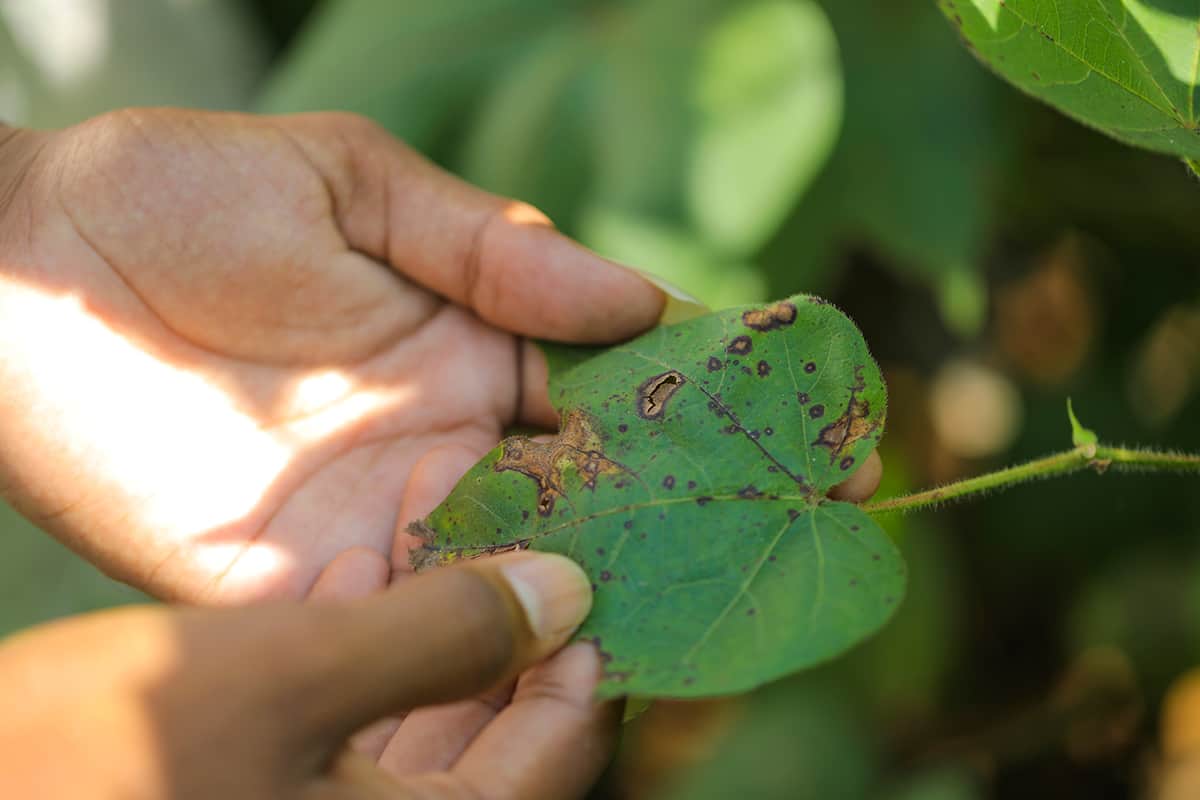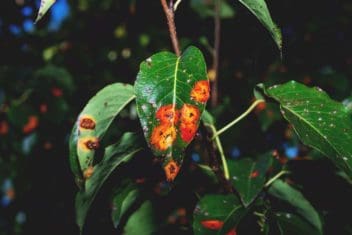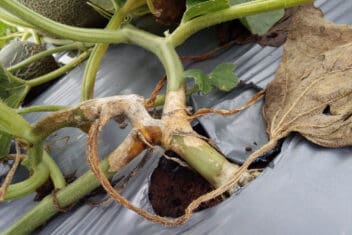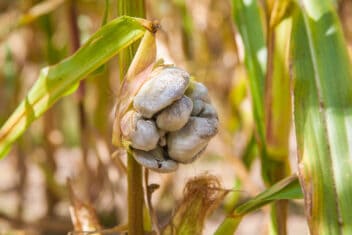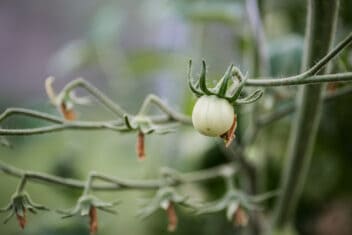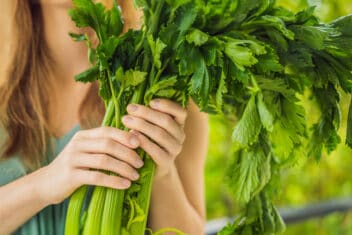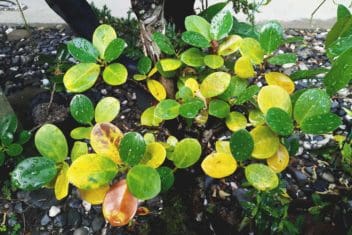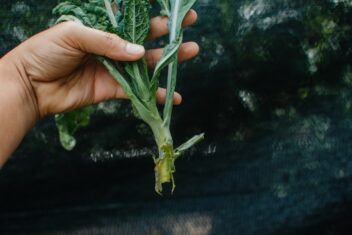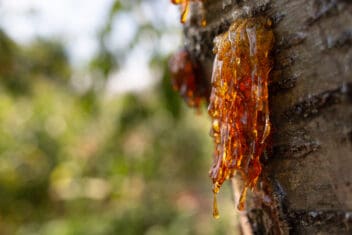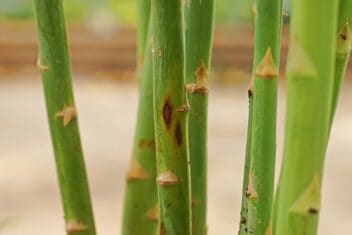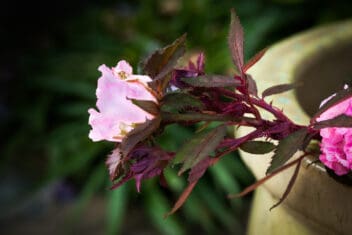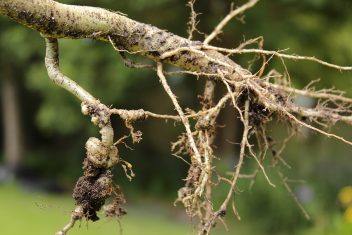Are there strange spots developing on the leaves of your plants? You might have bacterial leaf spot.
No gardener likes dealing with diseases, and bacterial leaf spot is a particularly nasty problem because there is no cure. There are ways to slow the spread, but once your plant has it, there’s no way to save it from its fate.
If you’re wondering if your plant is facing a sad death, keep reading to find out all about bacterial leaf spot.
What is Bacterial Leaf Spot?

Bacterial leaf spot is a plant disease that causes spots, often water-soaked, that spread across the plants’ foliage. Spots can be yellow, brown, or black. Infestations start small, appearing on just the foliage, fruit, or stems at first.
The bacteria gets in at an opening in the plant. It then spreads rapidly throughout the rest of the plant and then to other plants in your garden.
It can take over large sections of your garden, killing numerous plants. This disease spreads even faster in warm, humid conditions and when a gardener uses overhead watering instead of drip irrigation.
What Causes Bacterial Leaf Spot
The cause of bacterial leaf spot is microscopic bacteria that attack your plant. While symptoms are often the same, there are numerous bacteria that cause the disease.
Common genera include: Erwinia, Xanthomonas, Pseudomonas, Corynebacterium, and Agrobacterium.
It spreads most often in wet, warm conditions, which encourage bacteria formation and allow the disease to spread rapidly across the plants in your garden.
When the temperatures are between 77-86°F, the bacteria divides and multiplies rapidly, taking only hours to double in numbers.
It spreads the fastest during the summer months when it’s warm outside, and moisture abounds. If you use overhead sprinklers to water your plants, it results in enough moisture for the infection to spread.
It doesn’t require a lot of moisture to spread. All it takes is for the bacteria to splash up on the leaves from the soil.
The rapid rate at which this disease spreads is why the infection rate is so high once it finds your garden.
Once the disease takes hold, it leads to severe leaf loss, compromising the entire health of your garden.
The Signs of Bacterial Leaf Spot
The problem with bacterial leaf spot is that it shows up on plants in many different ways, making identifying this disease harder.
Some symptoms of bacterial leaf spot include:
- Black-edged lesions on the leaves
- Brown spots with yellow halos on the leaves
- Light and dark areas throughout the foliage
- Brownish-yellow edges of the leaf
- Papery, dry leaves that break off easily.
These spots are typically irregular and measure between 3/16 and 1/2 inches wide. It happens on all leaves, no matter if they’re at the top of the bottom of the plant. When clusters of spots happen on the leaves, they kill the tissue of the foliage.
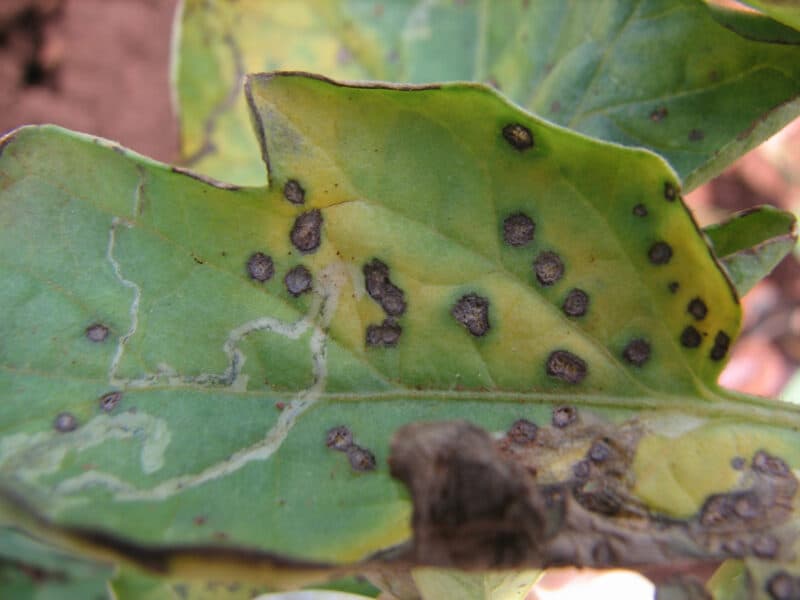
While the disease attacks all leaves, it’s most common on older leaves, especially when it causes leaves to turn papery. It spreads rapidly, so the new leaves are only safe for a short time.
Common Plants for Bacterial Leaf Spot
No plants are safe from this disease. It likes ornamental and edible plants, but some of the most common hosts are:
- Lettuce
- Beets
- Eggplant
- Peppers
- Philodendrons
- Stone fruit trees, such as apricot, peach, plum, and cherry
- Tomatoes
- Peppers
Bacterial leaf also infects some annual and perennial flowers, but not as often as they infect vegetable plants and fruit trees. Some common flowers that it attacks include:
- Zinnias
- Geraniums
- Purple Cone Flowers
- Black-Eyed Susan
How to Prevent Bacterial Leaf Spot
Prevention is the best course of action when it comes to this garden disease. Bacterial leaf spot is tough to treat, but there are plenty of preventative measures that stop the disease from making your garden its new home.
1. Plant Resistant Seeds
The first preventative measure is to plant disease-resistant seeds. Some seeds are resistant to specific bacteria, so make sure to read the description of the plants or seeds before you buy them.
2. Rotate The Crops
Many diseases, including bacterial leaf spot, live in the soil for years, so rotating your crops is essential. Some crops are more likely to fight off this disease, and others are more vulnerable.
3. Water at the Base
Never water overhead; water on the foliage encourages the spread of bacteria. We can’t control the rain, but we can control watering overhead. Always water your plants at the base.
If the bacteria live in the soil and water from a sprinkler splashes it up onto your plant, it can become infected. It’s that easy, so always avoid sprinklers. Drip irrigation systems are the way to go.
4. Remove Plant Debris
Plant debris creates a home for bacteria to live in, even if the plants were disease-free. Removing plant debris is even more important when the plants are infected by any disease.
5. Lay Mulch
Always lay a thick layer of mulch under your plants and trees to cover the soil. Mulch has several benefits in the garden, but when it comes to this disease, it stops water from splashing soil onto your leaves.
6. Prune and Stake Plants Regularly
Always stake large plants, like tomatoes, that have the possibility of tipping over and touching the ground. The leaves need to stay off of the ground where the bacteria lives.
Pruning is an important step to prevent bacterial leaf spot. It improves air circulation around your trees and plants.
Always disinfect your pruning equipment after each cut using a mixture of one part bleach and four parts water. You don’t want to spread bacteria to a healthy plant.
How to Treat Bacterial Leaf Spot
Treating bacteria leaf spot is hard, but there are some methods to try. Since it spreads rapidly, treatment needs to happen immediately. Delaying treatment leads to the death of an entire garden if left alone.

Unfortunately, these plants typically need to be removed from your garden to stop the spread from happening even further. Never compost plants that are infected with diseases; they’ll infect your entire compost.
1. Spread Copper Fungicide
One treatment method is using a copper fungicide spray on the crops. It’s only effective if it’s applied early in the disease cycle. If the disease has progressed, don’t expect this to work.
Copper sprays, when used weekly, may prevent the spread of this bacteria, but won’t get rid of it entirely.
2. Try a Baking Soda Solution
Some gardeners say that a baking soda solution works well to stop the spread. Mix one tablespoon of baking soda, 2 1/2 tablespoons of vegetable oil, and one teaspoon liquid dish soap in one gallon of water.
Use this when you notice signs of the disease. Spray every two weeks to help stop the progression.
Some plants burn when exposed to baking soda, so be sure to try just one or two before spraying your entire plant.
3. Neem Oil
Another option is to use neem oil to stop the spread of bacterial leaf spot. Remember, you won’t be able to get rid of it entirely, so slowing the spread is the next best bet.
Neem oil is one of the best treatment sprays for organic gardeners to have available at all times. It treats and prevents a range of common problems that gardeners face.
4. Try Copper and Pyrethrins
One safe treatment method for many fungal diseases and pests is Bonide Garden Dust, a combination of copper and pyrethrins. Cover the tops and undersides of leaves with a uniform layer of dust. Repeat the application every 7-10 days or as needed.
Final Thoughts
Bacterial leaf spot is one of the most troublesome diseases to experience in your garden. With no real cure or treatment, it spreads rapidly through gardens, taking out plants left and right.
Make sure you use preventative measures in your garden before this disease happens, and use these treatment options to reduce the spread to the best of your ability.
